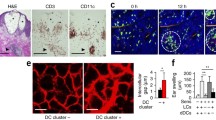Summary
Since alterations of epidermal Langerhans cells (LC) have been observed in humans infected with HIV, we investigated the morphology and function of these cells in murine acquired immunodeficiency syndrome (MAIDS), a murine model closely resembling human AIDS. The number as well as the shape of dendritic MHC class II+ cells from ear skin of C57BL/6 mice were similar in normal and infected animals. In mixed epidermal cell (EC) lymphocyte cultures, EC from infected mice and from normal mice stimulated allogeneic T cell proliferation to the same extent. In contrast to T cells from normal mice, however, T cells from infected mice did not respond to allogeneic spleen cells, confirming the presence of a T-cell defect in MAIDS. Subcutaneous injection of syngeneic mice with trinitrophenyl-modified MAIDS EC resulted in delayed ear swelling responses after challenge that were equivalent to those induced by hapten-modified EC from normal mice, suggesting that the contact sensitivity inducing potential of MAIDS LC was preserved. To investigate antigen presenting and processing function, EC and spleen cells were tested with the ovalbumin-specific IAb-restricted T cell hybridoma BO.17.10 and either ovalbumin 323–339 peptide or intact ovalbumin protein. MAIDS spleen cells had a reduced antigen presenting capacity compared with normal spleen cells, whereas EC from these mice showed the same processing and presenting capacity as normal controls. In summary, our results demonstrate that the frequency, morphology, level of MHC class II antigen expression and ability to process and present antigen is normal for LC from mice with MAIDS whereas the function of splenic T cells and APC from infected mice is significantly impaired.
Similar content being viewed by others
References
Aziz DC, Hanna Z, Jolicoeur P (1989) Severe immunodeficiency induced by a defective murine leukemia virus. Nature 338: 505–508
Basham T, Holdener T, Merigan T (1991) Intermittent, alternating, and concurrent regimens of zidovudine and 2′-3′dideoxycytidine in the LP-BM5 murine induced immunodeficiency model. J Infect Dis 163: 869–872
Belsito DV, Sanchez MR, Baer RL, Valentine F, Thorbecke GJ (1984) Reduced Langerhans' cell IA antigen and ATPase activity in patients with the acquired immunodeficiency syndrome. N Engl J Med 310: 1279–1279
Cerny A, Hügin AW, Hardy RR, Hayakawa K, Zinkernagel RM, Makino M, Morse III HC (1990) B cells are required for induction of T cell abnormalities in a murine retrovirus-induced immunodeficiency syndrome. J Exp Med 171: 315–320
Cerny A, Merino R, Makino M, Waldvogel FA, Morse III HC, Izui S (1991) Protective effect of cyclosporin A on immune abnormalities observed in the murine acquired immunodeficiency syndrome. Eur J Immunol 21: 1747–1750
Chattopadhyay SK, Morse III HC, Makino M, Ruscetti SK, Hartley JW (1989) A defective virus is associated with induction of a murine retrovirus-induced immunodeficiency syndrome, MAIDS. Proc Natl Acad Sci USA 86: 3862–3866
Hartley JW, Fredrickson TN, Yetter RA, Makino M, Morse III HC (1989) Retrovirus-induced murine acquired immunodeficiency syndrome: natural history of infection and differing susceptibility of inbred mouse strains. J Virol 64: 1223–1231
Hauser C, Snapper CM, Ohara J, Paul WE, Katz SI (1989) T helper cells grown with hapten-modified Langerhans cells produce interleukin 4 and stimulate IgE production. Eur J Immunol 19: 245–251
Hügin AW, Vacchio MS, Morse III HC (1991) A virus-encoded ‘superantigen’ in a retrovirus-induced immunodeficiency syndrome of mice. Science 252: 424–427
Juhlin L, Shelly WB (1977) New staining techniques for the Langerhans cell. Acta Derm Venereol (Stockh) 57: 289–296
Kalter DC, Greenhouse JJ, Orenstein JM, Schnittman SM, Gendelman HE, Melzer MS (1991) Epidermal Langerhans cells are not principal reservoirs of virus in HIV disease. J Immunol 146: 3396–3404
Kanitakis J, Escaich S, Trepo C, Thivolet J (1991) Detection of human immunodeficiency virus-DNA and RNA in the skin of HIV-infected patients using the polymerase chain reaction. J Invest Dermatol 97: 91–96
Main RK, Cochrum KC, Jones MJ, Kountz SL (1971) Immunological potential of the in vitro mixed skin cell-leukocyte reaction. Nature 229: 89–91
Mizuochi T, Mizuguchi J, Uchida T, Ohnishi K, Nakanishi M, Asano Y, Kakiuchi T, Fukushima Y, Okuyama K, Morse III HC, Komuro K (1990) A selective signaling defect in helper T cells induced by antigen-presenting cells from mice with murine acquired immunodeficiency syndrome. J Immunol 144: 313–316
Morse III HC, Yetter RA, Via CS, Hardy RR, Cerny A, Hayakawa K, Hügin AW, Miller MW, Holmes KL, Shearer GM (1989) Functional and phenotypic alterations in T cell subsets during the course of MAIDS, a murine retrovirus-induced immunodeficiency syndrome. J Immunol 143: 844–850
Mosier DE, Yetter RA, Morse III HC (1985) Retroviral induction of acute lymphoproliferative disease and profound immunosuppression in adult C57BL/6 mice. J Exp Med 161: 766–784
Rappersberger K, Gartner S, Schenk P, Stingl G, Groh V, Tschachler E, Mann DL, Wolff K, Konrad K, Popovic M (1988) Langerhans cells are an actual site of HIV-1 replication. Intervirology 29: 185–194
Rosenberg AS, Maniero TG, Morse III HC (1991) In vivo immunologic deficits in mice with the acquired immunodeficiency syndrome and the effect of LP-BM5 infection on rejection of skin from infected mice. Transplant. Proc 23: 167–169
Shimonkevitz R, Kappler J, Marrack P, Grey HM (1983) Antigen recognition by H-2-restricted T cells. I. Cell-free antigen processing. J Exp Med 158: 303–316
Tamaki K, Fujiwara H, Katz SI (1981) The role of epidermal cells in the induction and suppression of contact sensitivity. J Invest Dermatol 76: 275–278
Tschachler E, Groh V, Popovic M, Mann DL, Wolff K, Stingl G (1987) Epidermal Langerhans cells — a target for HTLV-III/LAV infection. J Invest Dermatol 88: 233–237
Zambruno G, Mori L, Marconi A, Mongiardo N, De Rienzo B, Bertazzoni U, Gianetti A (1991) Detection of HIV-1 in epidermal Langerhans cells of HIV-infected patients using the polymerase chain reaction. J Invest Dermatol 96: 979–982
Author information
Authors and Affiliations
Rights and permissions
About this article
Cite this article
Cerny, A., Izui, S., Saurat, J.H. et al. Epidermal and splenic antigen-presenting cell function in a retrovirally induced murine immunodeficiency syndrome (MAIDS). Arch Dermatol Res 284, 189–192 (1992). https://doi.org/10.1007/BF00375791
Received:
Issue Date:
DOI: https://doi.org/10.1007/BF00375791




